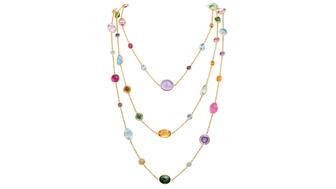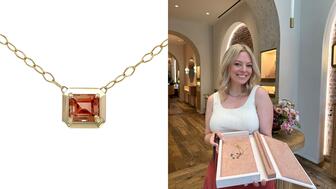Pandora’s New Lab-Grown Diamond Campaign Stars Pamela Anderson
Plus, Luciano Rodembusch, president of Pandora North America, shares his insight on valuation and sustainability.

The “Diamonds for All” campaign will highlight some familiar faces, including model and actress Pamela Anderson.
“I like the fact that these are lab-grown diamonds, and knowing the jewelry is crafted from recycled silver and gold makes me feel good about wearing it. It is actually the more radical, kind of glamorous move,” said Anderson.
She’s joined in the campaign by American Sign Language performer Justina Miles, model and Vogue Creative Director-at-Large Grace Coddington, actress Amita Suman, model Precious Lee, model Sherry Shi, and musical artist and dancer Vinson Fraley.
The campaign was shot in New York City by photographer Mario Sorren and directed by Gordon von Steiner.
It celebrates “the breaking of conventions and tells a new diamond story,” said Pandora.
“From ‘diamonds are a girl’s best friend’ to ‘diamonds are everyone’s best friend.’ From ‘diamonds on ring fingers’ to ‘diamonds on every finger.’”

Mary Carmen Gasco-Buisson, chief marketing officer at Pandora, said the new campaign will help consumers reimagine diamond traditions.
“Our diamonds are not for the few, for a once-in-a-lifetime occasion, or only for giving. They represent personal meaning that each of us can create,” said Gasco-Buisson.
Pandora first announced its move into the lab-grown diamond jewelry market in May 2021, stating it would no longer be using natural diamonds—a stone it, notably, used in only a small percentage of its jewelry—amid its push for “sustainably created” and affordable products.
It introduced its “Pandora Brilliance” collection to the United Kingdom before rolling out to new markets, landing in the United States and Canada last August.
Previously called “Diamonds by Pandora,” the company’s lab-grown diamond line is now called “Pandora Lab-Grown Diamonds.”
Within the U.S. jewelry trade, there is a polarizing debate around lab-grown diamonds, but Pandora has appeared confident in its move into the market.
Luciano Rodembusch, president of Pandora North America, shared his insights on Pandora’s lab-grown diamond collections and the market at large in an email interview with National Jeweler.
“We shifted from mined diamonds to exclusively lab-grown diamonds to lessen the impact on the planet and to deviate from unfair working practices in the mining industry,” he said.
“Because of this shift, we’ve been able to create a collection of diamonds that are more sustainable and more affordable for every consumer.”
Pandora has framed its move into lab-grown diamonds as a push for sustainability, a claim that some in the jewelry industry have taken issue with, but the company has remained firm on its stance.
“We are committed to making lab-grown diamonds more sustainable. Our diamonds are grown, cut and polished using renewable energy at our facilities and have a carbon footprint of only 9.17 kg CO2e per cut and polished carat,” said Rodembusch.
“Consumers will continue to purchase jewelry, and it is our responsibility to reduce our emissions, like with our lab-grown diamond collections, so we can reduce our impact on the planet.”
As noted on the company’s website, the diamonds Pandora uses in its jewelry are grown in the United States. It has been reported that they are grown at De Beers’ Lightbox factory in Gresham, Oregon, though officials from both companies have declined to comment on this claim.
Rodembusch noted Pandora’s second-quarter earnings surpassed analysts’ estimates, which he viewed as a positive signal for lab-grown diamond demand.
“By democratizing diamonds, we created an affordable jewelry line that brings quality, sustainable lab-grown diamonds to everyone, which is what we strive to do as a brand,” he said.
Rodembusch said its current lab-grown diamond collection is “performing accordingly with our expectations.”
“It was the largest contributor of new clients for the brand since its launch and we have received a large quantity of positive feedback from our clients. Those are some of the key reasons that motivated us to expand our [offerings with] new designs and new collections that we believe will accelerate our performance in the lab-grown diamond market [even more].”
Pandora began with a range of 36 designs but has expanded to 57 new styles across three new collections, with prices starting at $290.
“Pandora Nova” features round brilliant and princess-cut lab-grown diamonds in four-prong settings, meant to mimic the look of a floating diamond.
“Pandora Era” reimagines classic styles with bezel and prong settings.
“Pandora Talisman” is described as an “elevated take” on the company’s charms, created in 14-karat gold and set with brilliant-cut lab-grown diamonds.
Pandora Lab-Grown Diamonds are available online, in all U.S. stores, and select stores in Canada and the U.K. The new collections will be available Aug. 31.
The line will expand to Australia with select collections also available in Mexico and Brazil in October.
Another facet of the lab-grown diamond debate within the U.S. trade has been concerns about the lasting value, or possible lack thereof, of lab-grown diamonds.
When asked if Pandora shared that concern, Rodembusch said, “Not at all.”
“Since our first days, Pandora has been democratizing jewelry, creating affordable jewelry that can help people to express themselves. Now it is time for us to also democratize the diamond market. With lab-grown diamonds, we are allowing the dream of so many fans around the world to become a reality,” he said.
Its customers’ interest in lab-grown diamonds is growing, he said, due in part to shoppers being more sustainability focused and the draw of a lower retail price.
“The customer response has been fantastic! It’s our fastest-growing segment since its launch. We are excited to see how the lab-grown diamond collections perform in North America as we continue to expand the offerings,” he said.
The Latest

Said to be the first to write a jewelry sales manual for the industry, Zell is remembered for his zest for life.

The company outfitted the Polaris Dawn spaceflight crew with watches that will later be auctioned off to benefit St. Jude’s.

A buyer paid more than $100,000 for the gemstone known as “Little Willie,” setting a new auction record for a Scottish freshwater pearl.

Supplier Spotlight Sponsored by GIA.

Anita Gumuchian created the 18-karat yellow gold necklace using 189 carats of colored gemstones she spent the last 40 years collecting.


The giant gem came from Karowe, the same mine that yielded the 1,109-carat Lesedi La Rona and the 1,758-carat Sewelô diamond.

The three-stone ring was designed by Shahla Karimi Jewelry and represents Cuoco, her fiancé Tom Pelphrey, and their child.

Supplier Spotlight Sponsored by GIA

The Manhattan jewelry store has partnered with Xarissa B. of Jewel Boxing on a necklace capsule collection.

Acting as temporary virtual Post-it notes, Notes are designed to help strengthen mutual connections, not reach new audiences.

The jewelry historian discusses the history and cultural significance of jewelry throughout time and across the globe.

From fringe and tassels to pieces that give the illusion they are in motion, jewelry with movement is trending.

The designer and maker found community around her Philadelphia studio and creative inspiration on the sidewalks below it.

The change to accepted payment methods for Google Ads might seem like an irritation but actually is an opportunity, Emmanuel Raheb writes.

The industry consultant’s new book focuses on what she learned as an athlete recovering from a broken back.

The fair will take place on the West Coast for the first time, hosted by Altana Fine Jewelry in Oakland, California.

Hillelson is a second-generation diamantaire and CEO of Owl Financial Group.

Submissions in the categories of Jewelry Design, Media Excellence, and Retail Excellence will be accepted through this Friday, Aug. 23.

Known as “Little Willie,” it’s the largest freshwater pearl found in recent history in Scotland and is notable for its shape and color.

Clements Jewelers in Madisonville cited competition from larger retailers and online sellers as the driving factor.

The gemstone company is moving to the Ross Metal Exchange in New York City’s Diamond District.

Most of the 18th century royal jewelry taken from the Green Vault Museum in Dresden, Germany, in 2019 went back on display this week.

The Pittsburgh jeweler has opened a store in the nearby Nemacolin resort.

With a 40-carat cabochon emerald, this necklace is as powerful and elegant as a cat.

The Erlanger, Kentucky-based company was recognized for its reliability when it comes to repairs and fast turnaround times.

Unable to pay its debts, the ruby and sapphire miner is looking to restructure and become a “competitive and attractive” company.

The trend forecaster’s latest guide has intel on upcoming trends in the jewelry market.






















